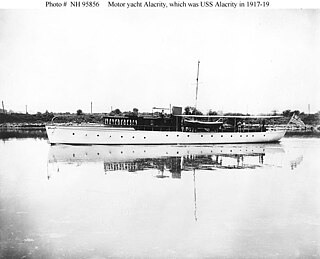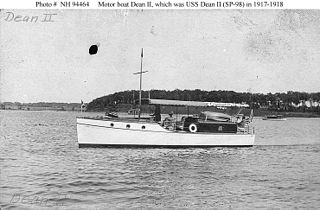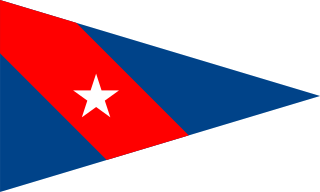
USS Impetuous (PYc-46) was a private yacht purchased by the Navy in August 1940 that served as a patrol boat of the United States Navy in Central America. The yacht was built as Paragon, the first of at least two Davol yachts to bear the name, in 1915 for Charles J. Davol of Providence, Rhode Island. In 1916 Davol sold the yacht to John Fred Betz, 3d of Philadelphia who renamed the yacht Sybilla III which served as the Section Patrol yacht USS Sybilla III (SP-104) from May 1917 to December 1918. Sybilla III remained in Betz's ownership until sale in 1935 to R. Livingston Sullivan of Philadelphia who renamed the yacht Arlis. On 12 August 1940 the Navy purchased the yacht placing it in commission as USS PC-454 on 16 October. The vessel was given the name Impetuous and reclassified PYc-46 on 15 July 1943. The yacht was decommissioned at Philadelphia 31 August 1944 and transferred to the War Shipping Administration for sale.

USS Alacrity (SP-206) was a steel cruising yacht that served in the US Navy as a section patrol craft. It was built by Pusey & Jones at Wilmington, Delaware for W. A. Bradford in 1910 then sold to John H. Blodgett of Boston.

USS Druid (SP-321) was a private yacht launched 10 February 1902 as Rheclair that was built for Daniel G. Reid. Reid sold the yacht to Senator Nelson W. Aldrich who renamed the yacht Nirvana only just over a year before his death. Aldrich's estate chartered Nirvana to John Wanamaker until it was bought by his son Rodman Wanamaker who used the yacht for cruising until a fire on 14 December 1916, just before a cruise south, severely damaged the vessel. He chartered an alternate vessel for his trip south and, after full repairs, the yacht was sold to Walter W. Dwyer who gave it the name Druid with intentions to sell the yacht to the government in order to finance a shipyard venture in Pensacola, Florida.

USS Zenith (SP-61) was an armed motorboat that served in the United States Navy as a Section patrol vessel from 1917 to 1918.

USS Lynx II (SP-730), later USS SP-730, was an armed motorboat that served in the United States Navy as a patrol vessel and harbor dispatch boat from 1917 to 1919.

USS Patrol No. 4 (SP-8), often rendered as USS Patrol #4, was an armed motorboat that served in the United States Navy as a patrol vessel from 1917 to 1919.

USS Patrol No. 1 (SP-45), often rendered as USS Patrol #1, was an armed motorboat that served in the United States Navy as a patrol vessel from 1917 to 1919.
USS Momo (SP-49) was an armed motorboat that served as a United States Navy patrol vessel from 1917 to 1919.

USS Rivalen (SP-63) was an armed motorboat that served in the United States Navy as a patrol vessel from 1917 to 1919.

The second USS Commodore (SP-1425) was an armed motorboat that served in the United States Navy as a patrol vessel from 1917 to 1919. It was financed by Herbert M. Sears as part of the "Eastern Yacht Club 62 footers".

USS Dean II (SP-98) was an armed motorboat that served in the United States Navy as a patrol vessel from 1917 to 1918.

USS Coco (SP-110) was an armed motorboat that served in the United States Navy as a Section patrol vessel from 1917 to 1919.

USS Apache (SP-729) was the first to be delivered of eight motor boats built by Herreshoff Manufacturing Company at Bristol, Rhode Island ordered and financed by members of the Eastern Yacht Club of Marblehead, Massachusetts. The boats were designed by Albert Loring Swasey and Nathanael Greene Herreshoff with the intention that the boats be used by the Navy as patrol craft and built with Navy approval of the design. Apache, as were the other boats, bore names under construction chosen by the owners and were then given the Section Patrol numbers on Navy acceptance and activation. The names were dropped after a period and all the boats then bore only the S.P. numbers.

USS Sans Souci II (SP-301) was an armed motorboat that served in the United States Navy as a patrol vessel from 1917 to 1919.

George Lawley & Son was a shipbuilding firm operating in Massachusetts from 1866 to 1945. It began in Scituate, then moved to Boston. After founder George Lawley (1823–1915) retired in 1890, his son, grandson and great-grandson upheld the business, which continued until 1945. Of the hundreds of ships built by the Lawleys, highlights include the yachts Puritan and Mayflower, respective winners of the 1885 and 1886 America's Cup.

USS Whistler (SP-784) was a United States Navy patrol vessel in commission from 1917 to 1919.
USS Shrimp (SP-645) was a United States Navy patrol vessel in commission from 1917 to 1918.
The first USS Rush (SP-712) was a United States Navy patrol vessel in commission during 1917.
USS Marpessa (SP-787) was a 50 foot "express yacht" that became a United States Navy section patrol vessel in commission from 1917 to 1919 retaining the civilian name.

The Eastern Yacht Club is located in Marblehead, Massachusetts and founded in 1870. It is one of the oldest yacht clubs on the east coast with significant involvement in the history of American yachting.
















